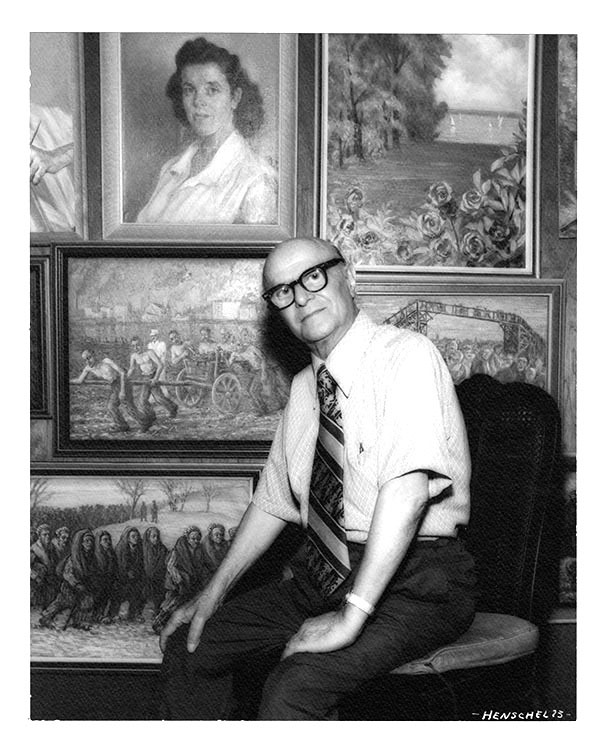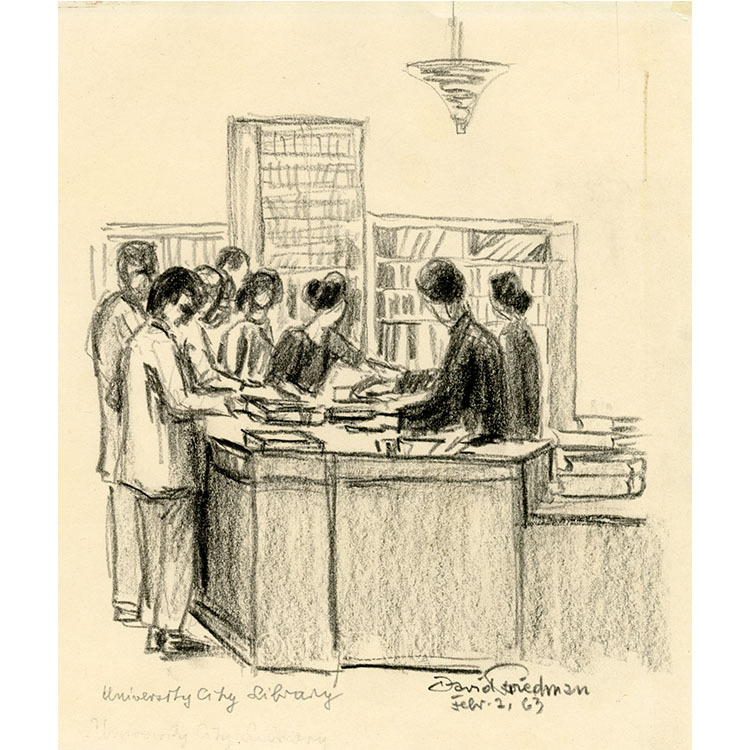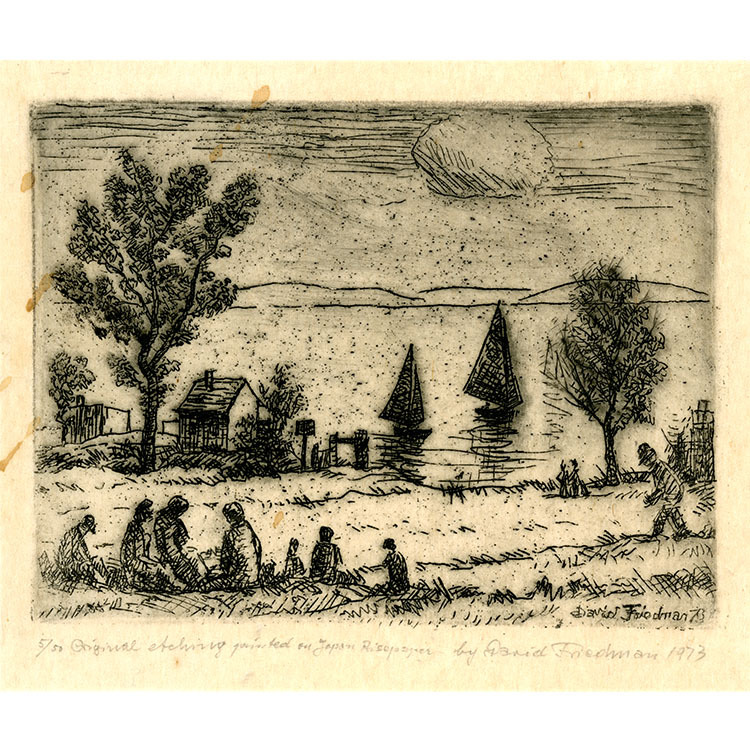David Friedman (originally Friedmann) was an Austrian-born painter, portraitist and graphic artist. His career as a commercial artist included freelance press work, theatrical scenery and outdoor billboards. A survivor of the Holocaust, his postwar journey led from Czechoslovakia to Israel and to the United States. He achieved acclaim as a painter known for his portraits drawn from life. Friedman’s talent for portraiture played a central role throughout his career and saved his life during the Holocaust.
Friedman was born December 20, 1893 in Mährisch Ostrau, Austro-Hungary (today Ostrava, Czech Republic) and showed an early interest in art and the violin. After apprenticing with a master sign-painter for three years, he ventured to Berlin in 1911 to develop his talents. He painted signs and then theatrical scenery and soon began studies with etcher Hermann Struck. Upon the recommendation of Max Liebermann, he met with Lovis Corinth and was accepted to study painting in his Studien-Atelier. At the advice of Corinth, he opened his own studio in 1914.
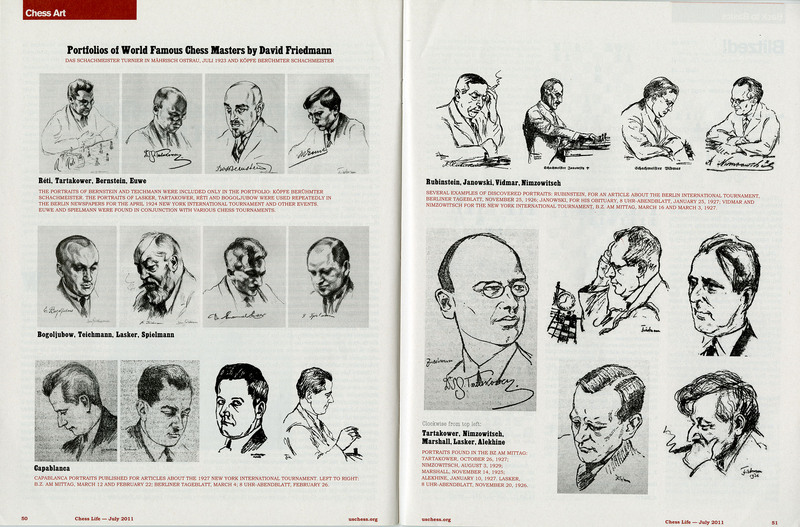
Recently located portraits of world famous chess masters published in Berlin newspapers of the 1920’s. The originals were looted by the Gestapo in 1941. Author, Miriam Friedman Morris published in Chess Life, July 2011.
During World War I, Friedman served in the Austro-Hungarian Army as a battle artist. He was decorated for producing sketches close to the actual fighting. Thereafter he portrayed distinguished generals and soldiers. Following his return to Berlin, Friedman resumed painting post-impressionist landscapes, nudes and still life, and continued his violin studies. He exhibited at the Akademie der Kunst, Berliner Secession and numerous galleries throughout Germany. At the end of 1923, Friedmann’s art was propelled into a new direction because of the widespread recognition for his portraits. He became a leading press artist for Berlin newspapers and the weekly radio-program magazine, Der Deutsche Rundfunk. He produced hundreds of portraits of celebrated contemporary personalities including Albert Einstein, composer Arnold Schönberg and chess champion Emanuel Lasker.
In 1933, Hitler's rise to power ended his successful prewar career. Jewish work prohibition forced Friedman to close his studio and remove his artwork from galleries. He earned his living by establishing a painting business, which was permitted because of his Czechoslovak citizenship. In December 1938, Friedman fled to Prague with his wife Mathilde and infant daughter Mirjam Helene, escaping from the Nazis with only his artistic talent as a means to survive. He introduced himself to the Jewish Community and soon was commissioned to portray the governing officials and their families.
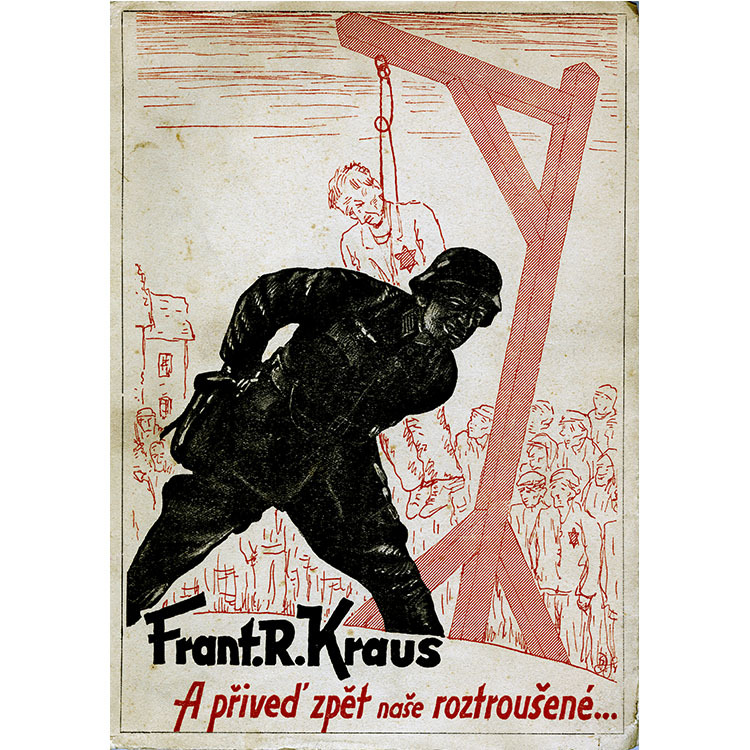
Friedman illustrated the covers of two of the first-ever Holocaust books published in Czechoslovakia. The title of the displayed book published in 1946 translates to: And Bring Back Our Scattered Ones.
The Friedman family was deported in October 1941 on the first transport to the Lodz Ghetto in Poland. Nazi authorities looted his left-behind artwork in Berlin and Prague. In the Ghetto, he painted scenes of his family and recorded the infernal daily life in his diary and artwork. He produced portraits of the Ghetto leaders in exchange for provisions in order for the family to survive. When the Ghetto was liquidated at the end of August 1944, Friedman was separated from his family and sent to the extermination camp Auschwitz-Birkenau. He never saw his wife or daughter again.
In September 1944, while in line at roll call, an announcement was made for musicians for an orchestra that performed for the German command. Although he had not played the violin in several years, Friedman volunteered. He passed the audition and was sent with other potential musicians to the Auschwitz subcamp Gleiwitz I. There he had to compete with the likes of concert masters and violin virtuosos. He failed to gain a position in the orchestra, but the lucky coincidence of the violin saved him from certain death in Auschwitz. However, he was in great danger and to save himself, he painted a mural across the barracks’ walls. Friedman’s painting skills impressed the SS officers and his life was spared. He was ordered to paint landscapes, portraits of the SS officers and even their dogs. Nevertheless, the act of painting gave Friedman solace and the will to live, and served as a form of resistance. When the camp was evacuated, he survived the death march to Blechhammer and was liberated by the Russian Red Army on January 25, 1945. He had defied all odds to survive at the age of 51 years.
Friedman believed there was a reason for his survival - to show to the world the persecution, torment and agony as practiced by the Nazis, in the hope that such barbarism would never happen again. He returned to Prague and soon began painting the unforgettable scenes he had witnessed and experienced in the Ghetto and the concentration camps.
In 1946, in the town of Českŷ Dub, near Prague, Friedman met Hildegard Taussig, a survivor of several concentration camps. She helped to hang his first showing of Holocaust-themed artwork. Exhibitions followed in Palestine, Prague and towns in the former Sudetenland (Western Bohemia). To balance the oppressive themes of persecution, Friedman simultaneously created portraits and picturesque landscapes of Western Bohemia, and in memory of his birth city, Ostrava, a series of paintings on the lives of coal mine workers in Habartov, Czechoslovakia.

Friedman in front of the Budweiser billboard he painted in January 1958 for General Outdoor Advertising in New York. This is one of 150 billboards he painted in Chicago and St. Louis until his retirement in 1962.
Friedman married Taussig in 1948, but barely a year later the couple fled from Stalinist Czechoslovakia to Israel. However, the country was in a poor economical situation and he set his sights on America. Determined to succeed with his art, Friedman immigrated to New York in 1954 with his wife and their daughter, also named Miriam.
To support his family, Friedman postponed creating additional Holocaust-themed artwork to focus on a commercial art career. At age 61, he auditioned for GOA -General Outdoor Advertising Company, Inc., in New York, by painting a portrait on a large billboard. The company was so impressed with Friedman's trial painting, that they hired him on the spot. He was transferred from New York City to Chicago, and in 1956, he accepted the position as top painter at the St. Louis branch. During his career at GOA, he produced 150 billboards for companies such as Hunts Tomato Sauce, 7-Up, Michelob and Falstaff Beer. His most famous billboards were for Budweiser, including paintings of the iconic Clydesdales. This opportunity gave him reason to believe that there was still a place where his ability as a painter could be honored. The new career brought recognition and satisfaction with life in America and the Friedmann family called St. Louis, Missouri home.
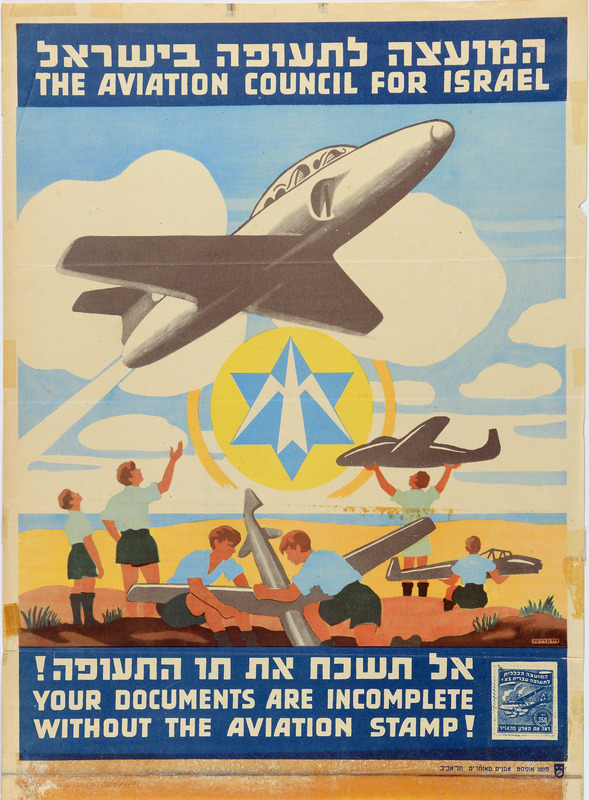
Stamp advertisement painted by Friedman, 1951. Collection of the Yad Vashem Art Museum, Jerusalem. Gift of Miriam Friedmann Morris in memory of her parents Hildegard and David Friedman
In 1960, the Friedman family became American citizens and dropped the second “n” from their name. Retiring from commercial art in 1962, Friedman continued with his artistic pursuits and exhibiting his works. He resumed his Holocaust-themed artwork with a series of charcoal drawings titled, Because They Were Jews!
Seeking respite from the anguish and pain of his memories that were relived while creating his artwork, Friedman would take trips to St. Louis libraries and a new exhibition was born: “I needed to forget about the concentration camps and the horror that was there …. So it was a pleasure to go to the library.” Traveling by bus from one library to another, 100 portraits were sketched. Occasionally he would visit more than one library in a day in search of interesting subjects. His keen observation captured the essence of the public’s enjoyment of the library. The drawings transmit the ambience of the library, the quiet concentration of the people and the hushed tones of the spoken word. Discreetly he sketched with his pad under the table or from behind a bookcase, the subjects unaware that they were being portrayed. Sometimes there was time for Friedman to produce multiple sketches before the subject moved. During the exhibitions that followed, viewers were amused to see themselves in a drawing. For a change of pace, he enjoyed roaming the streets, alleys and parks to capture the diverse moods of the city that resulted in the series titled, Urban Scene.
He continued with his portraiture work, etching, landscape painting, still life and abstract art. Friedman never ceased to bear witness about the Holocaust. He painted until six months before his death on February 27, 1980, at the age of eighty-six.
Most of Friedman’s prewar art was looted, lost or destroyed, along with works created in the Ghetto and concentration camp. His daughter Miriam Friedman Morris has successfully located significant pieces of his art and continues to search for the whereabouts of his missing works. Miriam’s pursuit is to ensure that David Friedman is recognized for his contributions to the art world and to preserve his legacy for future generations.
The works of David Friedman are represented in the collections of the United States Holocaust Memorial Museum, the State Museum Auschwitz-Birkenau, New Synagogue Berlin-Centrum Judaicum; the Jewish Museum in Prague, the Ostrava Museum, the Sokolov Museum, Czech Republic, the Koninklijke Bibliotheek, National Library of the Netherlands, the Cleveland Public Library, the St. Louis Public Library, and the permanent exhibitions of the St. Louis Holocaust Museum and Learning Center and the Holocaust History Museum, Yad Vashem, Jerusalem.
- Miriam Friedman Morris, 2014

